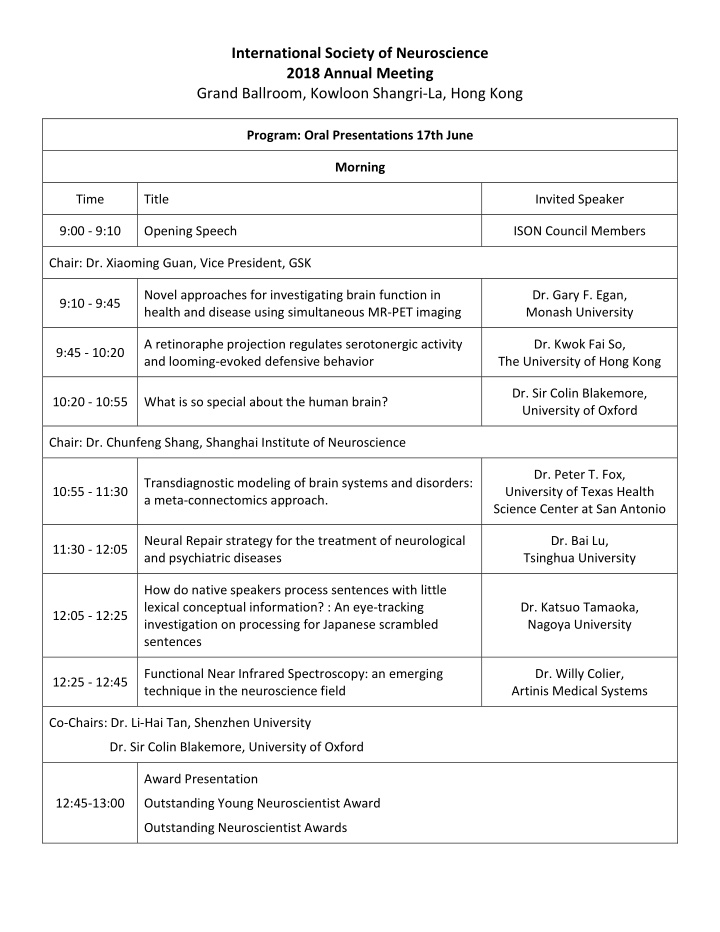



International Society of Neuroscience 2018 Annual Meeting Grand Ballroom, Kowloon Shangri‐La, Hong Kong Program: Oral Presentations 17th June Morning Time Title Invited Speaker 9:00 ‐ 9:10 Opening Speech ISON Council Members Chair: Dr. Xiaoming Guan, Vice President, GSK Novel approaches for investigating brain function in Dr. Gary F. Egan, 9:10 ‐ 9:45 health and disease using simultaneous MR‐PET imaging Monash University A retinoraphe projection regulates serotonergic activity Dr. Kwok Fai So, 9:45 ‐ 10:20 and looming‐evoked defensive behavior The University of Hong Kong Dr. Sir Colin Blakemore, 10:20 ‐ 10:55 What is so special about the human brain? University of Oxford Chair: Dr. Chunfeng Shang, Shanghai Institute of Neuroscience Dr. Peter T. Fox, Transdiagnostic modeling of brain systems and disorders: 10:55 ‐ 11:30 University of Texas Health a meta‐connectomics approach. Science Center at San Antonio Neural Repair strategy for the treatment of neurological Dr. Bai Lu, 11:30 ‐ 12:05 and psychiatric diseases Tsinghua University How do native speakers process sentences with little lexical conceptual information? : An eye‐tracking Dr. Katsuo Tamaoka, 12:05 ‐ 12:25 investigation on processing for Japanese scrambled Nagoya University sentences Functional Near Infrared Spectroscopy: an emerging Dr. Willy Colier, 12:25 ‐ 12:45 technique in the neuroscience field Artinis Medical Systems Co‐Chairs: Dr. Li‐Hai Tan, Shenzhen University Dr. Sir Colin Blakemore, University of Oxford Award Presentation 12:45‐13:00 Outstanding Young Neuroscientist Award Outstanding Neuroscientist Awards
Afternoon Time Title Speaker Chair: Dr. Sir Colin Blakemore, University of Oxford How do the Hierarchical Levels of Premises Affect Dr. Yi Lei, 14:00 ‐ 14:20 Category‐based Induction: Diverging Effects from the Shenzhen University P300 and N400 The role of sentence‐final particle ‐ ne in Japanese for Dr. Sachiko Kiyama, 14:20 ‐ 14:40 constructing interpersonal relations Tohoku University TMC proteins modulate membrane excitability through a Dr. Xiaomin Yue, 14:40 ‐ 15:00 background sodium‐leak conductance Zhejiang University Chair: Dr. Gui Xue, Beijing Normal University The effects of apolipoprotein E on default mode network Dr. Yao Zhu, 15:00 ‐ 15:15 in Alzheimer’s disease spectrum Southeast University Disrupted functional connectivity patterns of insula Dr. Chao Wang, 15:15 ‐ 15:30 subregions in major depressive disorder Shenzhen University A Word That Matters: Distinctive Neural Responses of Dr. Hao Yan, 15:30 ‐ 15:45 Affirmative and Negative Sentences across Two Xidian University Languages Dr. Pengfei Xu, Anxious Brain Networks: A Coordinate‐Based Meta‐ 15:45 ‐ 16:00 analysis of Resting‐State Functional Connectivity Studies Shenzhen Institute of in Anxiety Disorders Neuroscience Chair: Dr. Ping Li, Penn State University Decoding the intensity of sensory input by one C. elegans Dr. Wenjuan Zou, 16:00 ‐ 16:15 interneuron to regulate two types of behavioral outputs Zhejiang University Alleviation of Mechanical Allodynia Produced by 14,15‐ Dr. Xuhui Chen, 16:15 ‐ 16:30 epoxyeicosatrienoic Acid in a Central Post‐stroke Pain Huazhong University of Science Model: Possible Role of Allopregnanolone and δGABA A R s and Technology Brain activation and functional connectivity underlying Dr. Yang Yang, 16:30 ‐ 16:45 Chinese writing: an fMRI study Chinese Academy of Sciences 16:45 ‐ 17:00 Closing remarks
Oral Presentation Guidelines Equipment provided: Podium with microphone Wireless presenter A computer equipped with Windows (If you are a Macintosh user, please test your presentation on a PC to verify it converts to Windows format accurately) **To eliminate any delays to the start of the session, you are NOT recommended to use your own laptop for presentation. ** Please store your files into an USB, there will be a technician to assist you for setting up. You are highly recommended to give us your USB during registration on 16 th June for testing. In English Preferred format: PowerPoint in 4:3 ratio Use standard fonts, such as Times New Roman or Arial Avoid using small fonts that will be illegible from the back of the room, and break up a complex slide into a series of slides Presentations are most readable on a dark background and bright lettering Regarding the stability, do not rely on internet access If your presentation contains any video or audio, please try it on our computer during registration on 16 th June Allocated time: Please refer to the program rundown, there will be Q&A session after each presentation
Recommend
More recommend